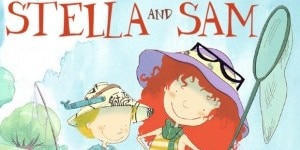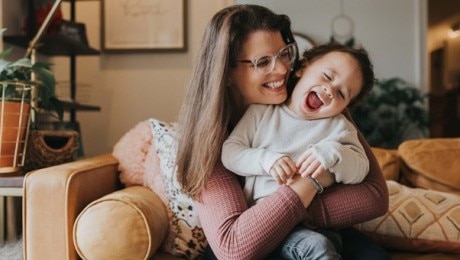
all
Stories
How Making a Video Game Helped My 11-Year-Old Deal With His Dad’s Suicide
By Paula M. Toledo
Photo © Supplied by Author
Oct 28, 2019
Content warning: This story is about a father's suicide, written by his wife and the mother of their two sons.
This month, a decade ago, the biggest sinkhole swallowed up my family.
At least, that is what it felt like when I lost my husband to his mental illness — by way of suicide.
At the time, my sons were just two weeks old and two years old. His illness eroded his physical and mental well-being, and hollowed out his human spirit.
It all lay below a tenuous cover.
You see, he was successful and deeply connected to everyone who loved him. So we didn’t see this coming — the hole took us all by surprise, a cavernous crater forming where our family once stood.
Surviving Spousal Suicide
Back then, there were no survivors around to inspire me, to help me figure out how my family and I could recover. I did the deepest dives into the internet. What I discovered, due to the stigma surrounding mental illness and suicide, was an even bigger digital hole. Not quite a rabbit hole — because this one seemingly had no bottom.
Friends told me to get back to work after my one year of maternity leave. Fearing I would collapse back into myself, back into the chasm, they encouraged me to keep busy.
My gut told me the opposite.
I was playing with my children through their hurt, but we were also having fun together.
Intuitively, I felt the most important thing I could do was to care for myself and my children. And so I did — albeit, while I laid in the dirt.
Instead of clawing my way out, I decided to surrender and play there with my young children. Insulated by the love of my sons, we all found wonder in our creations. Instead of sand castles, we built hospitals and ambulances.
It became obvious to me that my children were expressing their grief.
Play Time Doesn’t Mean Grief is On Hold
At that time, I was fortunate to meet my friend’s play therapist. She worked with families and taught parents how to enter their children’s inner emotional worlds through play.
I asked her to coach me. I so desperately wanted to help my children through the grief that showed up during their imaginary play. She encouraged me to dive into their wonder, to witness and validate their feelings.
By playing with my sons, I was able to teach them the emotional vocabulary related to the feelings that surfaced from their imaginations.

As their mom, I wanted my children to always know it was OK to talk about their feelings and their needs.
I was playing with my children through their hurt, but we were also having fun together. Through their discoveries and our wonder, I was helping them seed their emotional intelligence, empathy, self-expression and awareness to pay attention to where tense feelings showed up in their bodies.
Our play therapist then helped me to create our very own “toolbox” to physically release difficult feelings. The idea being, that tension and stress accumulated in our body breeds illness. To stay healthy, we need a place for them to exit.
If you have younger kids, this book list might help you discuss death in an age-appropriate way.
The Toolbox
As creative people, our tools were: helping others; art; music; mindfulness; travelling (novelty and discovering); sports and recreation. We turned this into an acronym to congratulate and remind ourselves to continually take care of our mental well-being.

We called it H.A.T.S. Off (Humanity, Arts and Awareness, Travel and Discovery, Sports and Recreation). H.A.T.S. Off became our family manifesto and daily prescription for our emotional health.
Suicide, Kids and The Truth
As they grew older, I carefully unpacked the debris of our old home that remained. When they asked questions about their father and how he died, I answered them truthfully, in an age-appropriate way. I didn’t share more than what they needed to know. I satisfied their curiosity and reinforced that I was their trusted scaffolding. We were going to build our new home and make it beautiful. We were all going to be OK.
We cried, danced and beatboxed. Three years ago, they asked me to explain the full story of their loss. I remember that day vividly.
When they asked questions about their father and how he died, I answered them truthfully, in an age-appropriate way.
They made up lyrics and sang an improvised song titled, Sui (short for suicide) Sucks. We had empty suitcases of ripped up angry letters that shared our hardest feelings. We played with Lego in made-up worlds where we expressed what was in our hearts, our minds and most of all in our worries.
I reassured them and taught them about mental illness, grief, death and that hard feelings are natural and OK if we express them in a healthy way. As they grew older, unbeknownst to me at the time, a lot of what I taught them was through my advocacy for mental health. By using platforms like my songwriting, a TEDx talk, a WE Day speech and my blog Ode to Wonder, I showed them that there can be joy despite loss. It was now their turn to watch me play, but this time with them and for others.
Creating Worlds to Thrive
As my sons grew older, they accumulated their own play toys. Entering into their pre-teens, having more peer connections, they found themselves immersed in digital play.
My eldest son acquired coding skills at school and through YouTube videos. His desire to raise awareness among youth about the importance of mental health, while sorting out his own understanding of his loss, led him to self-initiate and develop his own game titled "Let's Be Well", in Roblox — a video game platform, with tools to make and publish your own video games.
I let him go and make it his own project. With most of his friends playing in the digital world, he felt the camaraderie and fun could be a bridge to also buffer the intensity of a very difficult subject.

In his symbiotic world of digital play, my son is now reframing our tragedy, growing from it and helping others by demystifying mental illness.
We balance our lives through travel and spending time in nature. I don’t entirely shun digital play. I have seen my sons’ imaginations come to life in the same way whether they are sitting in the dirt, playing with a pile of Lego or clicking on digital assets in Roblox.
When I asked my son what he loves about his Roblox game, he says, “When you learn through play, the idea sticks with you, it doesn’t feel like you are learning at the time, because it just feels fun!”
Watch this video to see how another parent handles discussing death with their children.
Meet Bob: He Lives With Depression
In “Let’s Be Well” there is a main character by the name of Bob. Bob lives with depression. As Bob plays the "obby" (obstacle course), he jumps from grey blocks to coloured blocks, to symbolize his recovery. Signs pop up on the sides as he successfully makes his way and begins to feel better.

My son has picked up on things that have helped him nurture his own mental well-being. Playing with friends, spending time in nature and exercising are all programmed into the game. “It’s like the idea of muscle reflex,” he says. “If it becomes second nature to play in the playground with friends in the digital world, because it makes you feel better, then it’s my hope that kids will understand that they can also feel better if they do this in real life.”
Any form of play can be a resiliency building tool for our children.
My kids will be more than OK in life and I tell them so. If they, or anyone they love, were to ever uncover a sinkhole, they would have the confidence and the internal resources to build something from nothing. For if you can do this through play (as my son says, “It’s muscle reflex”), you can do this in real life.
Where to get help: Canada Suicide Prevention Service — phone 1-833-456-4566; text 45645 or chat at crisisservicescanada.ca | Association québécoise de prévention du suicide — phone 1-866-APPELLE (1-866-277-3553) | Kids Help Phone — phone 1-800-668-6868; or live chat at kidshelpphone.ca | Canadian Association for Suicide Prevention — find a 24-hour crisis centre.
Most Popular
-
 Ages:
Ages:
allStories
Childhood Is Too Short So Just Let The Teens Trick-Or-Treat
-
 Ages:
Ages:
allFamily Health
Why Being A Halloween Candy Micromanager Can Create Long-Term Problems For Kids
-
 Ages:
Ages:
allStories
My Daughter Wore a 1960s-Inspired ‘Indian’ Costume — And Here’s How I Took Care of That
-
 Ages:
Ages:
allStories
I’m Not Your Typical Mom — Here Are 5 Assumptions You Have All Wrong
-
 Ages:
Ages:
allStories
Here’s Why We’re Ditching Trick-or-Treating This Year
















 Remembrance Day
Remembrance Day



































Add New Comment
To encourage thoughtful and respectful conversations, first and last names will appear with each submission to CBC/Radio-Canada's online communities (except in children and youth-oriented communities). Pseudonyms will no longer be permitted.
By submitting a comment, you accept that CBC has the right to reproduce and publish that comment in whole or in part, in any manner CBC chooses. Please note that CBC does not endorse the opinions expressed in comments. Comments on this story are moderated according to our Submission Guidelines. Comments are welcome while open. We reserve the right to close comments at any time.
Submission Policy
Note: The CBC does not necessarily endorse any of the views posted. By submitting your comments, you acknowledge that CBC has the right to reproduce, broadcast and publicize those comments or any part thereof in any manner whatsoever. Please note that comments are moderated and published according to our submission guidelines.